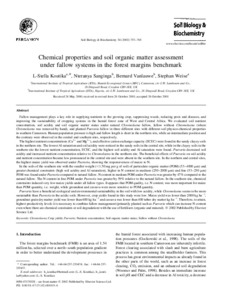| dc.identifier.citation | Koutika, L.S., Sanginga, N., Vanlauwe, B. & Weise, S. (2002). Chemical properties and soil organic matter assessment under fallow systems in the forest margins benchmark. Soil Biology and Biochemistry, 34(6), 757-765. |
| dc.description.abstract | Fallow management plays a key role in supplying nutrients to the growing crop, suppressing weeds, reducing pests and diseases, and improving the sustainability of cropping systems in the humid forest zone of West and Central Africa. We evaluated soil nutrient concentration, soil acidity and soil organic matter status under natural Chromolaena fallow, fallow without Chromolaena (where Chromolaena was removed by hand), and planted Pueraria fallow in three different sites with different soil physico-chemical properties in southern Cameroon. Human population pressure is high and fallow length is short in the northern site, while an intermediate position and the contrary were observed in the central and southern sites, respectively. The highest nutrient concentrations (Ca2+ and Mg2+), and effective cation exchange capacity (ECEC) were found in the sandy clayey soils in the northern site. The lowest Al saturation and soil acidity were noticed in the sandy soils in the central site, while in the clayey soils in the southern site the lowest nutrient concentration, ECEC, and the highest soil acidity and Al saturation were found. Pueraria decreased soil acidity and increased nutrient concentration relative to Chromolaena in the northern site. The beneficial effects of Pueraria on soil acidity and nutrient concentration became less pronounced in the central site and were absent in the southern site. In the northern and central sites, the highest maize yield was observed under Pueraria, showing the responsiveness of maize to N. In the soils of the southern site with the smaller weight (<1.50 mg per g of soil) of particulate organic matter (POM) (53–4000 μm) and greater chemical constraints (high soil acidity and Al saturation), higher in N content in medium (250–2000 μm) and fine (53–250 μm) POM was found under Pueraria compared to natural fallow. N content in medium POM under Pueraria was greater by 47% compared to the natural fallow. The N content in fine POM under Pueraria was greater by 59% relative to the natural fallow. In the southern site, chemical constraints induced very low maize yields under all fallow types. It appears that POM quality, i.e. N content, was more important for maize than POM quantity, i.e. weight, while groundnut and cassava were more sensitive to POM quantity. Pueraria have a beneficial ecological and environmental sustainability in the soil with low acidity, while Chromolaena seems to be more sustainable than Pueraria in the acidic soils. However, crop yields found in this study were low. Maize yield was lower than 2000 kg ha−1, groundnut grain dry matter yield was lower than 600 kg ha−1 and cassava was lower than 400 tuber dry matter kg ha−1. Therefore, to attain, highest productivity levels it is necessary to combine fallow management (primarily planted such as Pueraria which can increase N content even where there are chemical constraints or soil degradation) with the use of fertilisers (organic and mineral). |

